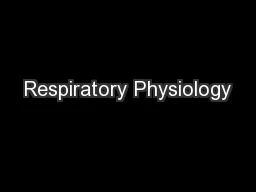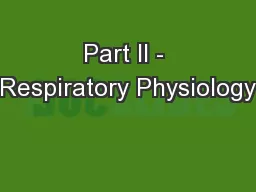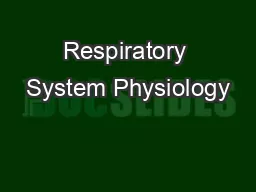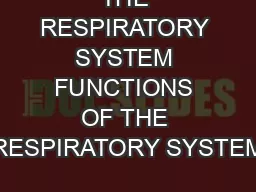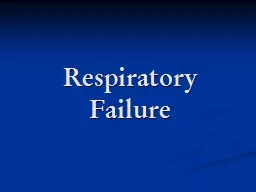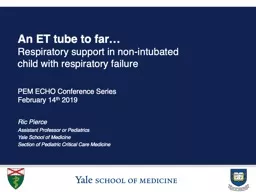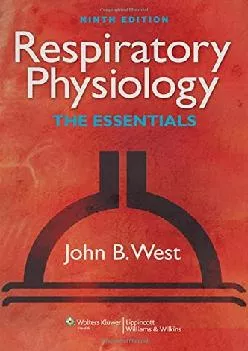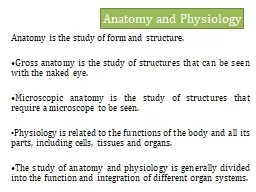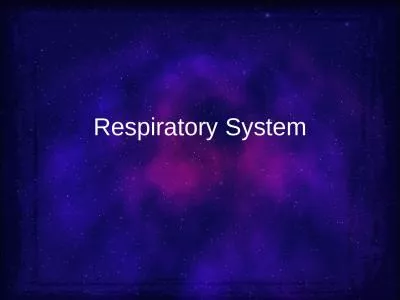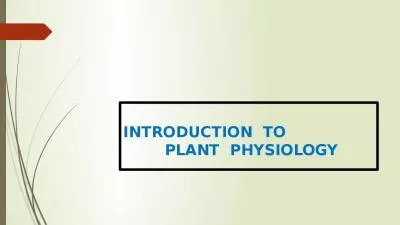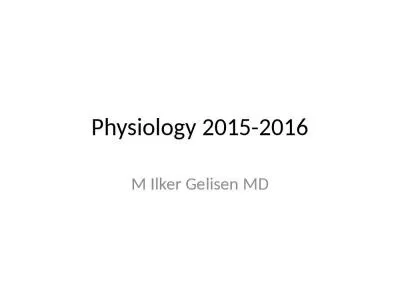PPT-Respiratory Physiology
Author : giovanna-bartolotta | Published Date : 2017-08-06
4 Parts of Respiration Pulmonary ventilation air moving into and out of lungs External respiration gas exchange blood alveoli Respiratory gas transport transport
Presentation Embed Code
Download Presentation
Download Presentation The PPT/PDF document "Respiratory Physiology" is the property of its rightful owner. Permission is granted to download and print the materials on this website for personal, non-commercial use only, and to display it on your personal computer provided you do not modify the materials and that you retain all copyright notices contained in the materials. By downloading content from our website, you accept the terms of this agreement.
Respiratory Physiology: Transcript
4 Parts of Respiration Pulmonary ventilation air moving into and out of lungs External respiration gas exchange blood alveoli Respiratory gas transport transport of gases via bloodstream. and . Nursing Diagnosis of Chronic Broncitis. Function of Respiratory System. Gas Exchange. . a. External respiration. . b. Internal respiration. . c. Cellular respiration. Ventilation. Blood Reservoir. 4 distinct events. Pulmonary ventilation. : air is moved in and out of the lungs. External respiration. : gas exchange between blood and alveoli. Respiratory gas transport. : CV system transports oxygen and carbon dioxide between lungs & tissues (discussed in Blood chapter). and Disorders. Gas Exchange. Gas exchange occurs in the alveoli due to the difference in the partial pressures of oxygen and carbon dioxide in the capillary blood and the alveoli.. Since the concentration of oxygen is greater in the alveoli, it diffuses into the capillary blood.. Transports air into the lungs and facilitates the diffusion of oxygen into the blood stream. Receives carbon dioxide from the blood and exhales it. Organs of the Respiratory system. Slide 13.1. Copyright © 2003 Pearson Education, Inc. publishing as Benjamin Cummings. Defined as the impairment of the lung’s ability to maintain adequate oxygen and carbon dioxide homeostasis.. Respiratory Failure - Definition. PaO. 2. < 60 mm Hg. and/or. PaCO. 2. > 50 mm Hg. care fieldAnatomy is the study of the structures associated with the human body Physiology is the these structures The humancomplicated machine In order for the machine addition each of these part PEM ECHO Conference Series. February 14. th. 2019. Ric Pierce. Assistant Professor or Pediatrics. Yale School of Medicine. Section of Pediatric Critical Care Medicine. Disclosures . I have no relevant financial interests to disclose. Widely considered the gold standard for the teaching and learning of respiratory physiology, this fully updated Ninth Edition includes key points for each chapter and multiple-choice review questions and answers with full explanations. Available online via thePoint, animations help to clarify particularly difficult concepts and provide a visual component for use during instruction or review. --NEW Presents rationales for all questions, as well as explanations for each answer choice--Provides 82 essential-to-know, multiple-choice review questions which appear at the end of each chapter--Features an Appendix of important equations--Supports learning through chapter-opening learning objectives and introductory material, as well as Key Concepts summaries at the end of each chapter--Includes online resources such as question bank, animations, and full text for students--Includes animations online--8 in total--via thePoint to illustrate particularly challenging concepts •Gross anatomy is the study of structures that can be seen with the naked eye.. •Microscopic anatomy is the study of structures that require a microscope to be seen. . Physiology is related to the functions of the body and all its parts, including cells, tissues and organs.. Definition Inability to meet one's need for tissue oxygenation and elimination of CO2, often but not always associated with distress.Will focus on Pulmonary aspects of this process.50% of pediatric I Lungs & Air passages. Responsible for taking in oxygen and removing carbon dioxide (CO. 2. ). 4 – 6 minute supply of oxygen. Includes: nose, pharynx, larynx, trachea, bronchi, alveoli, and lungs. laboratory safety rules for physiology . The following is a list of rules that is designed to ensure your safety as well as the safety of your classmates and instructor. . Failure to follow these safety rules may result in the removal from class on the day of the incident. . PLANT PHYSIOLOGY. *. Plant physiology is a subdiscipline of botany concerned with the functioning, or physiology, of plants.. . * Plant physiology closely related fields include Plant Morphology, Plant Ecology, Phytochemistry , Cell Biology, Genetics, Biophysics and Molecular Biology.. Ilker. . Gelisen. MD. Physiology. 3. THE DEFINITION OF . PHYSIOLOGY. . . . Physiology. ; . is the scientific study of function in living . systems. This . includes how organisms, organ systems, .
Download Document
Here is the link to download the presentation.
"Respiratory Physiology"The content belongs to its owner. You may download and print it for personal use, without modification, and keep all copyright notices. By downloading, you agree to these terms.
Related Documents

